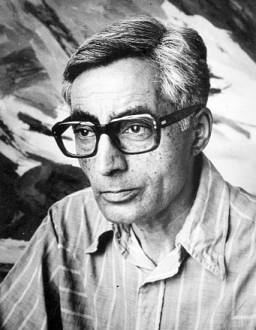Traveling to Varanasi, Ram Kumar, an exquisite artist, made this magical city his inspiration.
Throughout his long, prolific life, Ram Kumar has been one of India’s most widely celebrated artists. Born in Shimla, in Himachal Pradesh, India, he studied at the Sarada Ukil School of Art in New Delhi. In 1950, he left India for Paris and studied painting at the ateliers of Andre Lhote and Fernand Leger. His early years as a painter dealt with the human condition. So one encountered figures with vacant faces engulfed in urban surroundings where they probably did not belong. He returned to India soon thereafter, ripe with Modernist influences, particularly the stylings of Amedeo Modigliani. He was deeply disillusioned upon returning to India and for most of his subsequent career, his work was decidedly abstract which often featured subtly shifting, jagged patchworks of monochromatic lines, blocks and plains.
In 1969, he travelled to the United States and Mexico on a Rockefeller Scholarship, and from the 1970s, much of his work was based upon his personal recollections of experiences and memories of travels to remote, mountainous, ancient, spiritual centres in Northern India, Machu Picchu or the mountains and Buddhist monasteries of Ladakh.
The poet, critic and theorist Ranjit Hoskote said, “[Kumar] demonstrates that a painter can enact the innermost dramas of his culture while maintaining the individuality, even idiosyncrasy of his performance.”
His greatest works were his Benares landscapes which have become blue chip art in the world of international auctions. Kumar was a writer and thinker too and his books include The Face and Other Stories, Europe ke Sketch, The Sea and Other Stories, Ram Kumar, Shilalekh Tatha Anya Kahaniyan. He had close friendships with MF Husain, VS Gaitonde, Tyeb Mehta and Krishen Khanna. He had long associations with the Progressives and often exhibited with them.
It’s no secret that artists Ram Kumar and VS Gaitonde were close friends. But Kumar preferred to collect Gaitonde’s artworks. One such work owned by Kumar was an untitled oil canvas painting of Gaitonde. The painting which had a pride of place in his home, fetched the highest price at the recent South Asian modern contemporary art auction put up by Christie’s in London.
The 1975 work fetched $2,014,635 (33 per cent above estimate). Interestingly, Kumar bought this artwork from Gaitonde at a Delhi exhibition in mid 1970s. Kumar was keen on buying another painting. However, Tom Keehn, a common friend and Rockefeller Fund’s then India representative, requested Kumar to pick something else because he wanted Kumar’s first choice.
Kumar spent much of the latter part of his life in search for transcendence and awakening. “When one is young and beginning, one’s work is dominated by content, by ideas,” he said, “but as one grows older, one turns to the language of painting itself. I have grown detached. I want to find the same peace that the mystics found.”
In his lifetime, Kumar’s work has been displayed in more than 35 solo exhibitions in India with retrospectives in Mumbai, Delhi and Kolkata. He has also participated in group shows in Geneva, Paris, and others and at the biennales of São Paulo, Tokyo and Venice as well as the Royal Academy of Arts in London and the Arts Council of Great Britain. In 1993, a large retrospective of his work was held at the National Gallery of Modern Art, New Delhi. Despite being associated with the Indian modernist scene, the Progressive Artists Group as well as the Delhi Shilpa Chakra, he never easily fit into a simplistic modernist narrative constantly seeking to rediscover elemental origins within the lingua franca of the landscape. He was awarded the prestigious Padma Shri by the Indian Government in 1979, one of India’s highest civilian awards. He passed away on Saturday, in New Delhi. Kumar’s death was confirmed by an email statement from city-based Vadehra art gallery, which had a solo show of the artist — Ram Kumar: A journey within in 1996. “It is with a heavy heart that we bid a final farewell to one of the greats of Indian art and a dear friend, Ram Kumar. The gallery went on to host 22 solo exhibitions by Ram Kumar over the years. Arun Vadehra recalls how Kumar’s entire life, like his art was a “sadhana.” He said, “It was an effort where the result was often forgotten or the result was not what mattered, it was the effort that did.”
Writer: Team Viva
Courtesy: The Pioneer








 OpinionExpress.In
OpinionExpress.In















Comments (0)